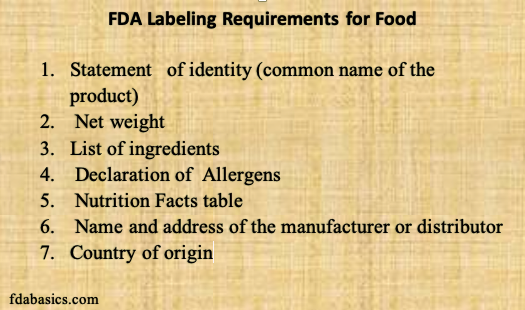3. Label units
Net content shall be expressed in terms of mass, volume, quantity, or the combination of quantity and mass or volume. Its marking unit: mass should be measured in pounds and ounces in the normal scale;
Volume of liquid foods should be measured in U.S. gallons and quarts, pints and fluid ounces at 231 cubic inches.
The volume of dry food shall be measured in U.S. bushels and pecks, dry quarts, and dry pints with a volume of 2150.42 cubic inches.
3. Ingredient list
The ingredient list is marked on the main display page or information page. The names of ingredients should be specific names rather than collections (types), except for spices, seasonings, pigments and chemical preservatives. If there are two or more ingredients, pay attention to the complete labeling. Compound ingredients shall be identified in descending order within parentheses immediately following.
4. Food labels should clearly and specifically indicate the business name and address of the manufacturer, packer or distributor.
5. Nutrition label
Nutrition labeling is an important part of the U.S. food labeling regulations. It is mandatory labeling. All foods for human consumption and sale should provide food-related nutritional information. Marked on the main display page or information page.
Please follow lnnuts.com ,you can get more.
The main content marked on the nutrition label is: the size of each meal and the number of servings in the package; calories, from fat
Calories, total fat, saturated fat, cholesterol, sodium, total carbohydrates, dietary fiber, sugar, protein and vitamin A, vitamin C, calcium and iron, as well as the daily consumption of relevant foods based on a recipe of 8360KJ calories percentage.
The following situations are exempt from nutritional labeling:
1. Small packaged foods with a total surface area of less than 12 square inches available for printing may not be labeled with nutritional statements or other nutritional information, but must be labeled with the address and phone number of the manufacturer, packer or distributor so that consumers can obtain the information. Required nutritional information.
2. A certain food can become a food subject to exemption requirements only if it meets the following conditions:
Foods prepared and processed through special procedures (as opposed to foods naturally occurring in natural conditions), which are taken orally or introduced into the intestine through a catheter for full or partial feeding to patients;
Food is used for diet management in conjunction with treatment for patients who, due to medical needs or chronic disease treatment needs, have incomplete or impaired functions in the intake, digestion, absorption or metabolism of ordinary food or specific nutrients, or other special nutrients determined by medicine. Requirements for which dietary management cannot be obtained merely by modifying the usual recipes; foods that provide special nutritional support necessary for a certain disease or health condition as diagnosed by a physician; foods that are prepared for use under the supervision of a medical professional , as well as preparing foods for use only by patients under special and continuous medical supervision who, among other needs, require cyclic treatment with the aid of medicinal foods;
Food that is shipped in bulk but is not sold to consumers in this form but is used solely for the manufacture of other foods, or that is to be processed, labeled, or repackaged at a location other than where it was originally processed or packaged. Raw fruits, vegetables, and fish subject to section 403(q)(4) of the Federal Food, Drug, and Cosmetic Act, but labeling shall comply with the relevant provisions of §101.45. The term "fish" includes freshwater fish and finned marine fish, crustaceans, molluscs, including aquatic shellfish, amphibians and other aquatic animals; single-component packaging consisting of fish or game meat subject to this section Products (i.e., meat products not covered by the Federal Meat Inspection Act or Poultry Products Inspection Act, such as fresh venison, bison, hare, quail, wild turkey, or ostrich meat products) may be provided with Nutritional information for a 3-ounce cooked edible portion (i.e., on an "as prepared" basis), except that foods making claims based on packaged content must provide nutritional information based on packaged status; and for special orders Nutritional information is not required for processed fish or hunted meats.
Hunted meats (i.e., meat products that are not covered by the Federal Meat Inspection Act or the Poultry Products Inspection Act, such as fresh venison, bison, hare, quail, wild turkey, or ostrich meat products) .
please follow lnnuts.com ,you can get more info .

